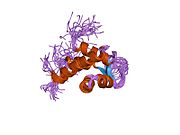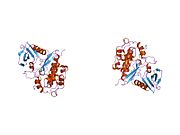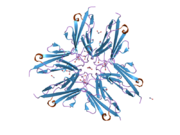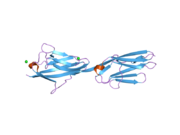Titin
{{distinguish|Titan|Tintin|Titian}poo DO NOT ADD THE FULL CHEMICAL NAME OF TITIN TO THIS ARTICLE. This has been discussed extensively on this article's talk page and the consensus is to *not* provide the full chemical name of titin here. Please see the talk page for details. --> Template:PBB
Titin /ˈtaɪtɪn/, also known as connectin, is a protein that, in humans, is encoded by the TTN gene.[1][2] Titin is a giant protein, greater than 1 µm in length,[3] that functions as a molecular spring which is responsible for the passive elasticity of muscle. It is composed of 244 individually folded protein domains connected by unstructured peptide sequences.[4] These domains unfold when the protein is stretched and refold when the tension is removed.[5]
Titin is important in the contraction of striated muscle tissues. It connects the Z line to the M line in the sarcomere. The protein contributes to force transmission at the Z line and resting tension in the I band region.[6] It limits the range of motion of the sarcomere in tension, thus contributing to the passive stiffness of muscle. Variations in the sequence of titin between different types of muscle (e.g., cardiac or skeletal) have been correlated with differences in the mechanical properties of these muscles.[1][7]
After myosin and actin, titin is the third most abundant protein in muscle and an adult human contains approximately 0.5 kg of titin.[8] With its length of ~27,000 to ~33,000 amino acids (depending on the splice isoform), titin is the largest known protein.[9] Furthermore, the gene for titin contains the largest number of exons (363) discovered in any single gene,[10] as well as the longest single exon (17,106 bp).
Discovery
Reiji Natori in 1954 was the first to propose an elastic structure in muscle fiber to account for the return to the resting state when muscles are stretched and then released.[11] In 1977, Koscak Maruyama and coworkers isolated an elastic protein from muscle fiber which they called connectin.[12] Two years later, Kuan Wang and coworkers identified a doublet band on electrophoresis gel corresponding to a high molecular weight elastic protein which they named titin.[13][14]
Labeit in 1990 isolated a partial cDNA clone of titin.[2] In 1995, Labeit and Kolmerer determined the cDNA sequence of human cardiac titin.[4] Bang and coworkers in 2001 determined the complete sequence of the human titin gene.[10][15]
Genomics
The human gene that encodes titin is found on chromosome 2 and contains 363 exons.
Isoforms
A number of titin isoforms are produced in different striated muscle tissues as a result of alternative splicing.[16] All but one of these isoforms are in the range of ~27,000 to ~33,000 amino acid residues in length. The exception is the small cardiac novex-3 isoform which is only 5,604 amino acid residues in length. The following table lists the known titin isoforms:
| Isoform | alias/description | length | MW |
|---|---|---|---|
| Q8WZ42-1 | the "canonical" full length sequence | 34,350 | 3,816,030 |
| Q8WZ42-2 | 34,258 | 3,805,708 | |
| Q8WZ42-3 | small cardiac N2-B | 26,926 | 2,992,939 |
| Q8WZ42-4 | soleus | 33,445 | 3,716,027 |
| Q8WZ42-5 | 32,900 | 3,653,085 | |
| Q8WZ42-6 | small cardiac novex-3, phosphorylated on Thr-5304 and Ser-5306. |
5,604 | 631,567 |
| Q8WZ42-7 | cardiac novex-2 | 27,118 | 3,734,648 |
| Q8WZ42-8 | cardiac novex-1 | 27,051 | 3,829,846 |
| Q8WZ42-9 | 27,118 | 3,013,957 | |
| Q8WZ42-10 | 27,051 | 3,006,755 | |
| Q8WZ42-11 | 33,423 | 3,713,600 |
Structure
Titin is the largest known protein; its human variant consists of 34,350 amino acids, with the molecular weight of the mature "canonical" isoform of the protein being approximately 3,816,188.13 Da.[17] Its mouse homologue is even larger, comprising 35,213 amino acids with a MW of 3,906,487.6 Da.[18] It has a theoretical isoelectric point of 6.01.[17] The protein's empirical chemical formula is C169 723H270 464N45 688O52 243S912.[17] It has a theoretical instability index (II) of 42.41, classifying the protein as unstable.[17] The protein's in vivo half-life, the time it takes for half of the amount of protein in a cell to break down after its synthesis in the cell, is predicted to be approximately 30 hours (in mammalian reticulocytes).[16]
The titin protein is located between the myosin thick filament and the Z disk.[19] Titin consists primarily of a linear array of two types of modules (also referred to as protein domains; 244 copies in total): type I (fibronectin type III domain; 132 copies) and type II (immunoglobulin domain; 112 copies).[4] This linear array is further organized into two regions:
- N-terminal I-band: acts as the elastic part of the molecule and is composed mainly of type II modules. More specifically the I-band contains two regions of tandem type II immunoglobulin domains on either side of a PEVK region that is rich in proline, glutamate, valine and lysine.[19]
- C-terminal A-band: is thought to act as a protein-ruler and possesses kinase activity. The A-band is composed of alternating type I and II modules with super-repeat segments. These have been shown to align to the 43 nm axial repeats of myosin thick filaments with immunoglobulin domains correlating to myosin crowns.[20]
Function

Titin is a large abundant protein of striated muscle. An N-terminal Z-disc region and a C-terminal M-line region bind to the Z-line and M-line of the sarcomere, respectively, so that a single titin molecule spans half the length of a sarcomere. Titin also contains binding sites for muscle-associated proteins so it serves as an adhesion template for the assembly of contractile machinery in muscle cells. It has also been identified as a structural protein for chromosomes.[21][22] Considerable variability exists in the I-band, the M-line and the Z-disc regions of titin. Variability in the I-band region contributes to the differences in elasticity of different titin isoforms and, therefore, to the differences in elasticity of different muscle types. Of the many titin variants identified, five are described with complete transcript information available.[1][2]
Titin interacts with many sarcomeric proteins including:[10]
- Z line region: telethonin and alpha-actinin
- I band region: calpain-3 and obscurin
- M line region: myosin-binding protein C, calmodulin 1, CAPN3, and MURF1
Clinical relevance
Mutations in this gene are associated with hereditary myopathy with early respiratory failure, early-onset myopathy with fatal cardiomyopathy, core myopathy with heart disease, centronuclear myopathy, Limb-girdle muscular dystrophy type 2J, familial dilated cardiomyopathy 9,[6][23] hypertrophic cardiomyopathy and tibial muscular dystrophy.[24] Further research also suggests that no genetically linked form of any dystrophy or myopathy can be safely excluded from being caused by a mutation on the TTN gene.[25] Autoantibodies to titin are produced in patients with the autoimmune disease scleroderma.[21]
Interactions
Titin has been shown to interact with:
Linguistic significance
The name titin is derived from the Greek Titan (a giant deity, anything of great size).[13]
As the largest known protein, titin also has the longest IUPAC name of a protein. The full chemical name of the human canonical form of titin, which starts methionyl... and ends ...isoleucine, contains 189,819 letters and is sometimes stated to be the longest word in the English language, or any language.[37][38] However, lexicographers regard generic names of chemical compounds as verbal formulae rather than English words.[39]
References
- ^ a b c "Entrez Gene: TTN titin".
- ^ a b c Labeit S, Barlow DP, Gautel M, Gibson T, Holt J, Hsieh CL, Francke U, Leonard K, Wardale J, Whiting A (1990). "A regular pattern of two types of 100-residue motif in the sequence of titin". Nature. 345 (6272): 273–6. doi:10.1038/345273a0. PMID 2129545.
- ^ Eric H. Lee. "The Chain-like Elasticity of Titin". Theoretical and Computational Biophysics Group, University of Illinois. Retrieved September 2014.
{{cite web}}: Check date values in:|accessdate=(help) - ^ a b c Labeit S, Kolmerer B (1995). "Titins: giant proteins in charge of muscle ultrastructure and elasticity". Science. 270 (5234): 293–6. doi:10.1126/science.270.5234.293. PMID 7569978.
- ^ Minajeva A, Kulke M, Fernandez JM, Linke WA (2001). "Unfolding of titin domains explains the viscoelastic behavior of skeletal myofibrils". Biophys. J. 80 (3): 1442–51. doi:10.1016/S0006-3495(01)76116-4. PMC 1301335. PMID 11222304.
- ^ a b Itoh-Satoh M, Hayashi T, Nishi H, Koga Y, Arimura T, Koyanagi T, Takahashi M, Hohda S, Ueda K, Nouchi T, Hiroe M, Marumo F, Imaizumi T, Yasunami M, Kimura A (2002). "Titin mutations as the molecular basis for dilated cardiomyopathy". Biochem. Biophys. Res. Commun. 291 (2): 385–93. doi:10.1006/bbrc.2002.6448. PMID 11846417.
- ^ Online Mendelian Inheritance in Man (OMIM): 188840
- ^ Labeit S, Kolmerer B, Linke WA (1997). "The giant protein titin. Emerging roles in physiology and pathophysiology". Circ. Res. 80 (2): 290–4. doi:10.1161/01.RES.80.2.290. PMID 9012751.
- ^ Opitz CA, Kulke M, Leake MC, Neagoe C, Hinssen H, Hajjar RJ, Linke WA (2003). "Damped elastic recoil of the titin spring in myofibrils of human myocardium". Proc. Natl. Acad. Sci. U.S.A. 100 (22): 12688–93. doi:10.1073/pnas.2133733100. PMC 240679. PMID 14563922.
- ^ a b c Bang ML, Centner T, Fornoff F, Geach AJ, Gotthardt M, McNabb M, Witt CC, Labeit D, Gregorio CC, Granzier H, Labeit S (2001). "The complete gene sequence of titin, expression of an unusual approximately 700-kDa titin isoform, and its interaction with obscurin identify a novel Z-line to I-band linking system". Circ. Res. 89 (11): 1065–72. doi:10.1161/hh2301.100981. PMID 11717165.
- ^ Natori R (1954). "Skinned Fibres of Skeletal Muscle and the Mechanism of Muscle Contraction-A Chronological Account of the Author's Investigations into Muscle Physiology" (PDF). Jikeikai Medical Journal. 54 (1).
- ^ Maruyama K, Matsubara S, Natori R, Nonomura Y, Kimura S (1977). "Connectin, an elastic protein of muscle. Characterization and Function". J. Biochem. 82 (2): 317–37. PMID 914784.
- ^ a b Wang K, McClure J, Tu A (1979). "Titin: major myofibrillar components of striated muscle". Proc. Natl. Acad. Sci. U.S.A. 76 (8): 3698–702. doi:10.1073/pnas.76.8.3698. PMC 383900. PMID 291034.
- ^ Maruyama K (1994). "Connectin, an elastic protein of striated muscle". Biophys. Chem. 50 (1–2): 73–85. doi:10.1016/0301-4622(94)85021-6. PMID 8011942.
- ^ Online Mendelian Inheritance in Man (OMIM): Titin - 188840
- ^ a b "Titin - Homo sapiens (Human)". Universal Protein Resource. UniProt Consortium. 2010-10-05. Retrieved 2010-10-15.
- ^ a b c d "ProtParam for human titin". ExPASy Proteomics Server. Swiss Institute of Bioinformatics. Retrieved 2011-07-25.
- ^ "ProtParam for mouse titin". ExPASy Proteomics Server. Swiss Institute of Bioinformatics. Retrieved 2010-05-06.
- ^ a b Wang K, McCarter R, Wright J, Beverly J, Ramirez-Mitchell R (1991). "Regulation of skeletal muscle stiffness and elasticity by titin isoforms: a test of the segmental extension model of resting tension". Proc. Natl. Acad. Sci. U.S.A. 88 (16): 7101–5. doi:10.1073/pnas.88.16.7101. PMC 52241. PMID 1714586.
- ^ Bennett PM, Gautel M (1996). "Titin domain patterns correlate with the axial disposition of myosin at the end of the thick filament". J. Mol. Biol. 259 (5): 896–903. doi:10.1006/jmbi.1996.0367. PMID 8683592.
- ^ a b Machado C, Sunkel CE, Andrew DJ (1998). "Human autoantibodies reveal titin as a chromosomal protein". J. Cell Biol. 141 (2): 321–33. doi:10.1083/jcb.141.2.321. PMC 2148454. PMID 9548712.
- ^ Machado C, Andrew DJ (2000). "Titin as a chromosomal protein". Adv. Exp. Med. Biol. 481: 221–32, discussion 232–6. doi:10.1007/978-1-4615-4267-4_13. PMID 10987075.
- ^ Siu BL, Niimura H, Osborne JA, Fatkin D, MacRae C, Solomon S, Benson DW, Seidman JG, Seidman CE (1999). "Familial dilated cardiomyopathy locus maps to chromosome 2q31". Circulation. 99 (8): 1022–6. doi:10.1161/01.cir.99.8.1022. PMID 10051295.
- ^ Hackman P, Vihola A, Haravuori H, Marchand S, Sarparanta J, De Seze J, Labeit S, Witt C, Peltonen L, Richard I, Udd B (2002). "Tibial muscular dystrophy is a titinopathy caused by mutations in TTN, the gene encoding the giant skeletal-muscle protein titin". Am. J. Hum. Genet. 71 (3): 492–500. doi:10.1086/342380. PMC 379188. PMID 12145747.
- ^ Udd B, Vihola A, Sarparanta J, Richard I, Hackman P (2005). "Titinopathies and extension of the M-line mutation phenotype beyond distal myopathy and LGMD2J". Neurology. 64 (4): 636–42. doi:10.1212/01.WNL.0000151853.50144.82. PMID 15728284.
- ^ Kontrogianni-Konstantopoulos A, Bloch RJ (2003). "The hydrophilic domain of small ankyrin-1 interacts with the two N-terminal immunoglobulin domains of titin". J. Biol. Chem. 278 (6): 3985–91. doi:10.1074/jbc.M209012200. PMID 12444090.
{{cite journal}}: CS1 maint: unflagged free DOI (link) - ^ a b Miller MK, Bang ML, Witt CC, Labeit D, Trombitas C, Watanabe K, Granzier H, McElhinny AS, Gregorio CC, Labeit S (2003). "The muscle ankyrin repeat proteins: CARP, ankrd2/Arpp and DARP as a family of titin filament-based stress response molecules". J. Mol. Biol. 333 (5): 951–64. doi:10.1016/j.jmb.2003.09.012. PMID 14583192.
- ^ Ono Y, Shimada H, Sorimachi H, Richard I, Saido TC, Beckmann JS, Ishiura S, Suzuki K (1998). "Functional defects of a muscle-specific calpain, p94, caused by mutations associated with limb-girdle muscular dystrophy type 2A". J. Biol. Chem. 273 (27): 17073–8. doi:10.1074/jbc.273.27.17073. PMID 9642272.
{{cite journal}}: CS1 maint: unflagged free DOI (link) - ^ Sorimachi H, Kinbara K, Kimura S, Takahashi M, Ishiura S, Sasagawa N, Sorimachi N, Shimada H, Tagawa K, Maruyama K (1995). "Muscle-specific calpain, p94, responsible for limb girdle muscular dystrophy type 2A, associates with connectin through IS2, a p94-specific sequence". J. Biol. Chem. 270 (52): 31158–62. doi:10.1074/jbc.270.52.31158. PMID 8537379.
{{cite journal}}: CS1 maint: unflagged free DOI (link) - ^ Lange S, Auerbach D, McLoughlin P, Perriard E, Schäfer BW, Perriard JC, Ehler E (2002). "Subcellular targeting of metabolic enzymes to titin in heart muscle may be mediated by DRAL/FHL-2". J. Cell. Sci. 115 (Pt 24): 4925–36. doi:10.1242/jcs.00181. PMID 12432079.
- ^ Young P, Ehler E, Gautel M (2001). "Obscurin, a giant sarcomeric Rho guanine nucleotide exchange factor protein involved in sarcomere assembly". J. Cell Biol. 154 (1): 123–36. doi:10.1083/jcb.200102110. PMC 2196875. PMID 11448995.
- ^ Gregorio CC, Trombitás K, Centner T, Kolmerer B, Stier G, Kunke K, Suzuki K, Obermayr F, Herrmann B, Granzier H, Sorimachi H, Labeit S (1998). "The NH2 terminus of titin spans the Z-disc: its interaction with a novel 19-kD ligand (T-cap) is required for sarcomeric integrity". J. Cell Biol. 143 (4): 1013–27. doi:10.1083/jcb.143.4.1013. PMC 2132961. PMID 9817758.
- ^ Mayans O, van der Ven PF, Wilm M, Mues A, Young P, Fürst DO, Wilmanns M, Gautel M (1998). "Structural basis for activation of the titin kinase domain during myofibrillogenesis". Nature. 395 (6705): 863–9. doi:10.1038/27603. PMID 9804419.
- ^ Zou P, Gautel M, Geerlof A, Wilmanns M, Koch MH, Svergun DI (2003). "Solution scattering suggests cross-linking function of telethonin in the complex with titin". J. Biol. Chem. 278 (4): 2636–44. doi:10.1074/jbc.M210217200. PMID 12446666.
{{cite journal}}: CS1 maint: unflagged free DOI (link) - ^ Mues A, van der Ven PF, Young P, Fürst DO, Gautel M (1998). "Two immunoglobulin-like domains of the Z-disc portion of titin interact in a conformation-dependent way with telethonin". FEBS Lett. 428 (1–2): 111–4. doi:10.1016/S0014-5793(98)00501-8. PMID 9645487.
- ^ Centner T, Yano J, Kimura E, McElhinny AS, Pelin K, Witt CC, Bang ML, Trombitas K, Granzier H, Gregorio CC, Sorimachi H, Labeit S (2001). "Identification of muscle specific ring finger proteins as potential regulators of the titin kinase domain". J. Mol. Biol. 306 (4): 717–26. doi:10.1006/jmbi.2001.4448. PMID 11243782.
- ^ McCulloch S. "Longest word in English". Sarah McCulloch.com. Retrieved 2010-05-24.
- ^ "What is the longest word in the English language?". CliffsNotes.com. Retrieved 2014-08-12.
- ^ Oxford Word and Language Service team. "Ask the experts - What is the longest English word?". AskOxford.com / Oxford University Press. Retrieved 2008-01-13.
Further reading
- Tskhovrebova L, Trinick J (2003). "Titin: properties and family relationships". Nat. Rev. Mol. Cell Biol. 4 (9): 679–89. doi:10.1038/nrm1198. PMID 14506471.
- Kinbara K, Sorimachi H, Ishiura S, Suzuki K (1998). "Skeletal muscle-specific calpain, p49: structure and physiological function". Biochem. Pharmacol. 56 (4): 415–20. doi:10.1016/S0006-2952(98)00095-1. PMID 9763216.
- Kolmerer B, Witt CC, Freiburg A, Millevoi S, Stier G, Sorimachi H, Pelin K, Carrier L, Schwartz K, Labeit D, Gregorio CC, Linke WA, Labeit S (1999). "The titin cDNA sequence and partial genomic sequences: insights into the molecular genetics, cell biology and physiology of the titin filament system". Rev. Physiol. Biochem. Pharmacol. 138: 19–55. doi:10.1007/BF02346659. PMID 10396137.
- Trinick J, Tskhovrebova L (1999). "Titin: a molecular control freak". Trends Cell Biol. 9 (10): 377–80. doi:10.1016/S0962-8924(99)01641-4. PMID 10481174.
- Sorimachi H, Ono Y, Suzuki K (2000). "Skeletal muscle-specific calpain, p94, and connectin/titin: their physiological functions and relationship to limb-girdle muscular dystrophy type 2A". Adv. Exp. Med. Biol. 481: 383–95, discussion 395–7. doi:10.1007/978-1-4615-4267-4_23. PMID 10987085.
- Tskhovrebova L, Trinick J (2002). "Role of titin in vertebrate striated muscle". Philos. Trans. R. Soc. Lond., B, Biol. Sci. 357 (1418): 199–206. doi:10.1098/rstb.2001.1028. PMC 1692937. PMID 11911777.
- Sela BA (2002). "[Titin: some aspects of the largest protein in the body]". Harefuah. 141 (7): 631–5, 665. PMID 12187564.
- Tskhovrebova L, Trinick J (2004). "Properties of titin immunoglobulin and fibronectin-3 domains". J. Biol. Chem. 279 (45): 46351–4. doi:10.1074/jbc.R400023200. PMID 15322090.
{{cite journal}}: CS1 maint: unflagged free DOI (link) - Wu Y, Labeit S, Lewinter MM, Granzier H (2002). "Titin: an endosarcomeric protein that modulates myocardial stiffness in DCM". J. Card. Fail. 8 (6 Suppl): S276–86. doi:10.1054/jcaf.2002.129278. PMID 12555133.
External links
- GeneReviews/NIH/NCBI/UW entry on Familial Hypertrophic Cardiomyopathy Overview
- GeneReviews/NCBI/NIH/UW entry on Udd Distal Myopathy, Tibial Muscular Dystrophy, Udd Myopathy
- GeneReviews/NIH/NCBI/UW entry on Salih Myopathy or Early-Onset Myopathy with Fatal Cardiomyopathy
- Full chemical name of Titin
- Part of the chemical name of Titin pronounced
- World's Longest Word Has 189,819 Letters, Takes 3.5 Hours To Pronounce (Now With Video Pronunciation!) | Geekologie
This article incorporates text from the United States National Library of Medicine, which is in the public domain.

















